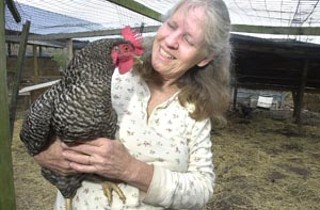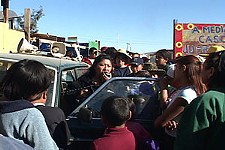Feds' Animal ID Program Raises Ruckus Among Small Farmers
National Animal Identification System favors factory farms over Ma and Pa
By Frank Rivera, Fri., March 17, 2006

Carol Ann Sayles, co-owner with her husband Larry Butler of East Austin's landmark organic Boggy Creek Farm, is surrounded by a clucking mob. She spreads freshly harvested lettuce and escarole, as her henhouse descends into lunchtime disorder. Sayles is famously proud of her flock, even compiling tales of the chickens for her children's book, Stories From the Hen House. Lately, however, Sayles' fondness for her pets and feathered farmhands has turned to apprehension, as Texas legislators have been preparing local farmers for the application of the new National Animal Identification System. And more than a few independent farmers aren't particularly keen on the letter of this law.
The National Animal Identification System was first conceived by Secretary Ann Veneman's U.S. Deptartment of Agriculture in December 2003. At first, it was an attempt to soothe public worries over the incidence of mad cow disease, and was in fact created at the behest of the meatpacking industry, as foreign markets – specifically that of Japan – began to get skittish over American beef. Then, in the wake of the more recent media blitz over the international spread of avian flu, poultry giants climbed on board.
Although the federal NAIS exists only in draft form, the last Legislature enacted HB 1361, a law that would ratify for Texas the eventual federal program. As it currently stands, the NAIS would follow a three-tiered program. The first step would require that any premises where livestock or poultry are kept – be it a home, ranch, or otherwise – have registered business or personal information with a USDA database. As of December, the Texas Animal Health Commission has registered over 4,000 premises, and plans to make the process mandatory by July 1. The next step involves assigning seven-digit identification numbers, and tags or implanted computer chips, to individual animals. (There's an exception for large herds moved as a group in the production process – as is often the case with the companies that control most meatpacking and distribution – that would require only a single group or lot number.) Finally, according to a fact sheet distributed by the TAHC, owners will have to record and notify the USDA whenever an animal is "moved, sold, commingled, or slaughtered." The nebulous language of the NAIS appears to encompass recording of activity as elaborate as a cattle drive, or as simple as a daily horse ride.
Recognizing the benefits large corporations can reap from these attempts to monitor and protect their products, Sayles worries about how this could affect her and other small farmers in terms of loss of time and funds. "Time is money, and you're going to be inside doing paperwork. It's estimated that somebody with 500 cows is going to be having to do 2,000 notifications to the USDA every year," she says, "and the producer – that's us – the farmer, and even your Aunt Mary, will have to pay all the costs associated with it. USDA's not going to pay anything." On that score she's correct; in fact, owners will be expected to pay the estimated $5-a-head price for individual tags or surgically implanted chips (for livestock), which does not include either chip implantation or the detection device used to check the chip's effectiveness. There's even a proposed $1,000-a-day noncompliance fee.
Judith McGeary, a local attorney representing the Texas Organic Farmers and Growers Association, charges that there are also constitutional questions about the NAIS. For example, the program may conflict with the First Amendment – in Wisconsin, where this system is already enforced, Mennonite communities are contemplating emigration to Canada because they consider the technology an encroachment on their religious freedoms. There are also privacy concerns, since the computer chip or tag attached to an animal could provide the government nearly any degree of supervision. Some chips would allow the USDA the ability to pick up radio signals, others are equivalent to a global positioning system tracking device. McGeary points out, "An owner of a chicken will be under stricter surveillance than an owner of a gun."
On Feb. 17, the TAHC met publicly to discuss the first stage of premise identification, and the negative reaction was such that a public meeting was initially scheduled for mid-March. That meeting has since been cancelled, and the next opportunity for public discussion is May 4, although the actual agenda is yet to be determined. In a prepared statement, TAHC executive director Dr. Bob Hillman said, "The agenda for that meeting will not be developed until late April. It is too early to know whether the proposed regulations will be considered at that meeting."
Sayles says she understands the necessity for disease prevention in livestock and poultry, but considers the NAIS as planned simply too burdensome a solution. "They can make it voluntary for everybody," she argues, "or they can limit it to certain segments of factory farms and leave the little guy out." The costs, the minutiae of compliance, and what she considers government interference in ownership of her own chickens, will be just too much to bear. If the NAIS is enacted as currently planned, Sayles says, she will likely have no choice but to abandon her henhouse and her feathered, egg-producing friends. "When they go," she shakes her head, "that's the soul of the farm."
Got something to say on the subject? Send a letter to the editor.









